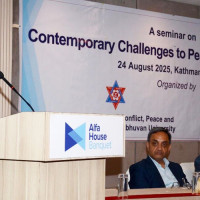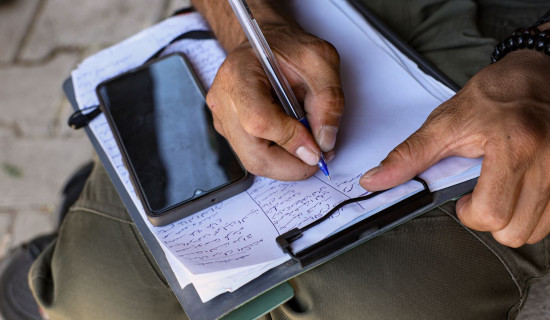- Monday, 25 August 2025
Watchtower built to deter dacoits in Kalyanpur turns popular hangout
By Hari Prasad Koirala,Morang, Aug. 15: The Tung Ghar (watchtower) at Kalyanpur in Ratuwamai-1, southern Morang, has now become a hangout for youth and students.
These days, new view towers, resembling the old Tung, have been built in various places. But Kalyanpur’s Tung Ghar was not constructed for sightseeing or attracting tourists.
Back in 1969, the residents of the then Bardanga-7 Kalyanpur built a 40-foot wooden Tung Ghar to keep watch against frequent attacks by armed dacoits from across the Indian border. However, when the Kalyanpur-Ambari-Urlabari road was upgraded, the wooden structure ended up in the road’s right of way.
In 2006, during road expansion, the wooden tower was demolished. The locals then began building a concrete replacement, said Rajendra Baral, secretary of the construction committee.
At that time, towers were built in several villages of southern Morang, including Larikatta, Karsiya, Singari, Sauntha and Kalyanpur, as dacoits from across the border frequently targeted the villages bordering India.
As security posts and police presence increased after the political changes in the country, the need for such towers faded.
But since Kalyanpur had the oldest and most well-known tower, residents decided to preserve its legacy by constructing a permanent one in the same spot. According to one local, Govinda Koirala, the aim was to ensure future generations could see the structure and hear its story from the elders.
It took nearly 12 years to complete the construction of the 65-foot-tall concrete tower. Built on three kattha of walled land, it has now become a popular attraction for young people. Koirala said that on Saturdays and public holidays, students travel from afar to see it.
The tower’s story is closely linked to migration history. When Myanmar came under military rule, the government there expelled many Nepalis in 1964. King Mahendra settled these displaced people along the southern border as a human shield against cross-border threats. According to Kalyanpur elders, 120 families were given plots of land and homes then.
Recalling stories from his elders, Koirala said, “In 1968, after a series of bandit attacks, Kalyanpur residents appealed to the then Chief District Officer, Bhakta Bahadur Koirala, for protection. He ordered the construction of a watchtower and instructed locals to take turns keeping watch and alerting villagers if dacoits approached. Following his orders, in 1969, villagers brought timber from the forest and built a 40-foot-tall tower. Even after that, it took nearly 10 years to properly settle all the 120 families migrated from Burma.”
Despite the area’s majority being indigenous and Muslim communities, religious and social harmony has always prevailed in Kalyanpur.
The 11-storey, 65-foot tower was built mostly through local effort. The Road Department gave Rs. 25,000 in compensation when the old wooden tower was demolished and the timber was sold for Rs. 60,000. With the Rs. 85,000 raised, locals planned the new tower.
Eventually, around Rs. 1.4 million was collected, mostly from donations sent by young people working abroad.
Government support was minimal -- Rs. 75,000 from the then Bardanga VDC and Rs. 56,000 from the Parliamentary Development Fund, said construction secretary Rajendra Baral.



-original-thumb.jpg)
-square-thumb.jpg)

-original-thumb.jpg)









